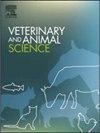Mitigating heat stress in full-time grazing dairy cows in temperate climates: The impact of indoor housing during the hottest time of day
IF 1.9
Q2 AGRICULTURE, DAIRY & ANIMAL SCIENCE
引用次数: 0
Abstract
We hypothesised that bringing full-time grazing dairy cows indoors during the hottest time of summer days could reduce heat stress if barns are cooler than outdoor. A 51-day pilot study on 19 pasture-based Swiss dairy farms revealed that, with daily mean ambient temperatures between 15 and 22 °C, barns were on average 2.5 °C cooler than pasture between 1000 and 1800 h. In an experiment over two summers, 38 Holstein dairy cows were investigated in 12 experimental periods of up to three consecutive days, with a mean daily comprehensive climate index between 23.6 and 28.5 °C. Cows experienced two treatments with a cross-over after each experimental period: half of the cows stayed on pasture full time except during milking, while the other half was brought inside the barn from 1130 h until afternoon milking and was supplemented with hay. During this time, barn conditions were cooler (mean and SD −2.9 ± 3.8 °C) than those on pasture. Between 0830 and 1100 h, when all cows were on pasture, no differences in physiological and behavioural indicators were detected in relation to treatment. Between 1200 and 1430 h, cows kept inside had lower vaginal temperature, reticular temperature, heart rate and respiration rate compared with those on pasture. Cows kept inside spent less time feeding and walking, but more time ruminating and lying down. These results suggest that bringing dairy cows inside during the hottest time of summer days reduces heat stress in grazing systems if barns are cooler than outdoors.
缓解在温带气候下全职放牧奶牛的热应激:在一天中最热的时间室内住房的影响
我们假设,如果谷仓比室外凉爽,在夏季最热的时候把全职放牧的奶牛带到室内可以减少热应激。在瑞士19个牧场奶牛场进行的为期51天的试点研究表明,在1000至1800小时期间,平均环境温度在15至22°C之间,谷仓比牧场平均温度低2.5°C。在一个为期两个夏天的实验中,38头荷斯坦奶牛在连续3天的12个实验期内接受了调查,平均每日综合气候指数在23.6至28.5°C之间。在每个试验期结束后,奶牛进行了两次交叉处理:一半奶牛除了挤奶期间一直呆在牧场上,而另一半奶牛从1130 h到下午挤奶期间被带到牲口棚内,并补充干草。在此期间,畜棚条件比牧场更凉爽(平均和标准差为−2.9±3.8°C)。在08:30至11:00之间,当所有奶牛都在牧场上时,没有检测到与治疗有关的生理和行为指标的差异。1200 ~ 1430 h,圈养奶牛阴道温度、网状温度、心率和呼吸速率均低于放牧奶牛。被关在室内的奶牛吃东西和走路的时间更少,但更多的时间是反刍和躺下。这些结果表明,在夏季最热的时候,如果谷仓比室外凉爽,将奶牛带到室内可以减少放牧系统中的热应激。
本文章由计算机程序翻译,如有差异,请以英文原文为准。
求助全文
约1分钟内获得全文
求助全文
来源期刊

Veterinary and Animal Science
Veterinary-Veterinary (all)
CiteScore
3.50
自引率
0.00%
发文量
43
审稿时长
47 days
 求助内容:
求助内容: 应助结果提醒方式:
应助结果提醒方式:


